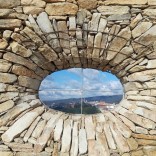In the Bosque de Galicia (Galicia's Forest) resides the artistic intervention entitled Espellos (Mirrors) by the artist Manolo Paz with the aim of strengthening the link between this architectural complex with the Ruta Xacobea (Jacobean Route) and the city of Santiago de Compostela.
It is composed of large stone cylinders that function as a large stone window from which to contemplate the Galician capital from a unique perspective.
These two artistic pieces aim to arouse the interest of the walkers with the intention of making them stop along the way to observe – before reaching desired goal of the cathedral – the original perspective of it (the cathedral) offered from this summit, integrated into the natural environment of the Capital of Galicia.
In addition to offering a different panoramic view of the Galician capital, these pieces of 3.5 metres high by 3.8 metres wide and 12 tons of weight will also serve to further strengthen the connection of the Cidade da Cultura with the Camino de Santiago, as the Via de la Plata runs parallel to Mount Gaiás, through the Compostelan district of Sar.
Connexion between the Gaiás and the Camino
The name Espellos (Mirrors) comes from the image that every walker has in mind of the cathedral as the ultimate goal of the pilgrimage or the Camino, and that the central window of these two sculptures allows it to reflect a few steps before the arrival.
This connection, the stone construction – obtained from the Compostelan stonework of Lamas de Abade – refers purposely to the numerous fences of the interior paths of the different Jacobean Routes and how he opted for the double arch – so characteristic of the Romanic style and so present in the art of the Camino – to construct the interior ocular opening from which the view of the Cathedral is framed.
In this symbolic argument, there is also an invocation of the “castreño” culture or culture of forts, so deeply rooted in Galicia, since in a play of perspective the Mirrors refer to the Celtic forts, in this case raised vertically, instead of lying on the ground.
Manolo Paz
Manolo Paz is, along with Francisco Leiro, one of the most personal and imaginative artists of the universalised Galician sculpture. He became known in 1979, with his participation in the 5th National Biennial of Pontevedra, in which his vaguely humanised stones, with a reasoned and yet elemental chip, were surprising. His success took him to be present in numerous subsequent editions and was always one of the most admired artists.
His works travelled around Galicia and got to Madrid and other cities in Spain, as well as Portugal. With the aforementioned Leiro and with the painters Menchu Lamas and Antón Lamazares he confirmed his status at the International University Menéndez Pelayo in Santander, during the mid-80s, until he got to New York, Germany and Japan, consolidating his condition as a new recognised value.
Nowadays, he has an established name and a body of work that can be found in museums and institutional collections in Galicia, Spain, and numerous countries in the world.





